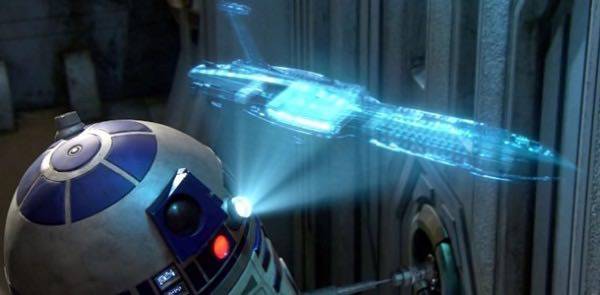
Movies are filled with big, bright 3D holographic images. Whether it is Tom Cruise manipulating items out of thin air in Minority Report or Robert Downey Jr. going all mad scientist in Iron Man, 3D images have little real-world equivalent.
We can dream though.
Holographic and more advanced volumetric displays are just but a twinkle in scientists’ eyes. True 3D projections for commercial or industrial uses is still years away. (The “Futurist’s Cheatsheet” series surveys technologies on the horizon: their promise, how likely they are, and when they might become part of our daily lives. This article is Part 4.)
What Is It?
You remember in Star Wars Episode IV – A New Hope when Leia sent a message to Obi-Wan through R2-D2? The little picture of Leia imploring, “help me Obi-Wan, you’re my only hope.” That was a holographic display. Taking holographic displays further, there is also the notion of volumetric displays that create a life-like 3D object.
According to 2002 research done by Actuality Systems, “volumetric displays create imagery that appears to float in a volume.” The image can be seen from a variety of angles without screens or goggles.
How It Works
There are two ways that volumetric displays can be created: swept-volume display and static-volume display. Swept-volume displays use the persistence of vision to create volumetric images from “rapidly projected 2D ‘slices,’” according to Gartner’s description of in the 2012 Hype Cycle report. This can be done by projecting images onto rotating mirrors within an enclosure. Static-volume displays use “voxels” (the volumetric equivalent of pixels) to create 3D images.
Potential Impact
A holographic display would allow you to talk with a representation of a person through a communicator terminal, like the small disk that Darth Vader used to communicate with Emperor Palpatine. A volumetric display could go further, showing a person that looks real but is instead only a visual representation. In the short term, there is little practical application for these technologies.
The advantages of a high-definition volumetric display (HDVD) could be applied to a variety of industries. Drug creation, medical imaging, oil exploration, mathematical analysis, airport security and product design could all benefit.
Challenges
Volumetric displays are expensive and difficult to produce and are barely beyond research phases. Holographic displays are a little more common, such as in retail environments. Perhaps the most impressive commercially produced holograph is Hatsune Miku, a complete holographic Japanese pop star that performs live on stage. Much of the challenge involved is finding a business model that supports the technology. In relation to our current technology (we are just getting used to FaceTime), there is as yet little need for holographic or volumetric displays.
Holographic and volumetric displays require a lot of computing power and moving parts, which could make systems unstable.
“The use of holographic techniques is, by far, the most advanced, but due to the intensive computing calculations required to generate the holographic image, the cost of generating the display image is one of the hurdles toward real-life adoption,” wrote Gartner’s Stephen Prentice.
When Will It Be Ready?
Very simple volumetric displays have been prototyped, and there are basic holographic technologies in use. But the full vision of the technology is much further over the horizon, perhaps 20 to 30 years.
While some commercial uses of holographic technology will be seen sooner than later, the true depth of volumetric displays will take a lot of time to develop and make commercially viable. The advantages of 3D displays, such as visualizing large data sets will eventually be a significant way in which research is conducted. It is cool to think of, but you will not be talking to your mother via hologram any time soon.
Additional Information
Actuality Systems (2002): 100 Million-Voxel Volumetric Display (PDF)
Stereoscopic Displays and Applications (2003): A Static Volume 3D-Laser Display (PDF)
Spie.org: Volumetric 3D display provides true perception of objects





















